Maximize Space with Small Vertical Sheds
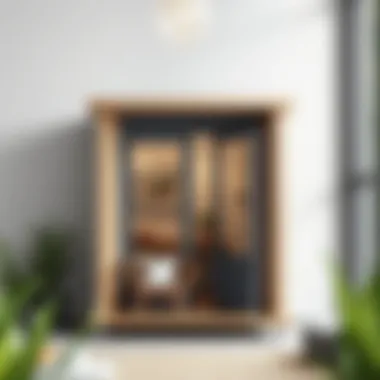
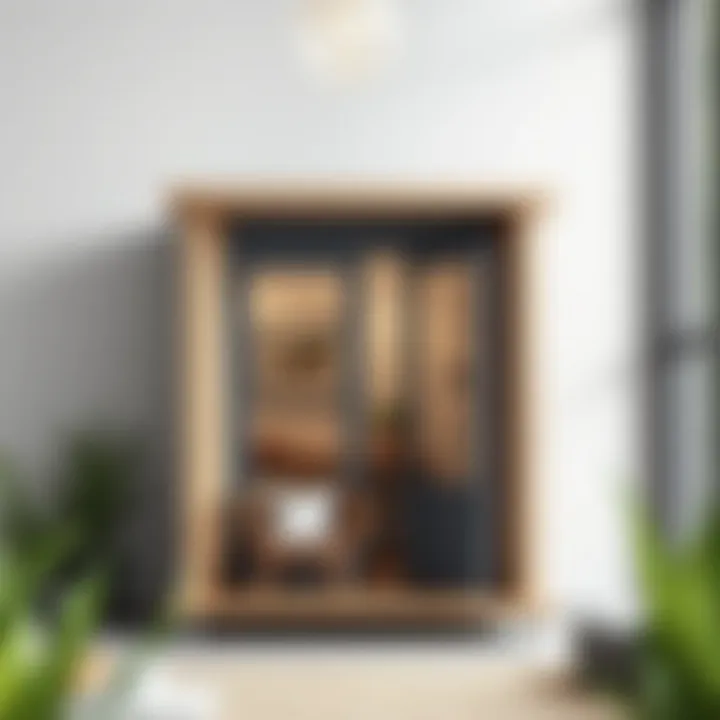
Intro
When it comes to optimizing outdoor spaces, small vertical sheds offer a practical yet stylish solution. These compact structures can fit into tight areas where horizontal sheds simply won't do. With the right design, such sheds can not only serve as storage for garden tools or outdoor furniture but also as functional workspaces or creative sanctuaries. As homeowners and design enthusiasts search for innovative ways to make the most out of their property, the significance of small vertical sheds can't be overstated.
This guide aims to shed light on various aspects of these installations—from materials and construction methods to design philosophies and maintenance tips. Whether you're a DIY enthusiast looking to take on a project or a seasoned designer exploring new trends, there's something here for everyone.
Let's explore the world of small vertical sheds, where functionality meets creativity, and uncover ideas that can help you transform your outdoor space into something truly special.
Furniture Design Insights
Understanding the nuances of furniture design within the confines of a vertical shed can greatly enhance its overall utility. Not only do design choices influence functionality, they also dictate the shed's aesthetic appeal. Here's a closer look at two vital components:
Understanding Style Preferences
Before diving headfirst into construction, it's essential to understand your style preferences. Consider the overall theme of your outdoor space. If your garden is modern and minimalist, high-gloss finishes with clean lines could do the trick. Conversely, if your yard leans toward a rustic vibe, using reclaimed wood or earthy colors might be more appropriate.
Here are a few design styles to contemplate:
- Modern: Sleek designs often incorporate metal and glass, yielding a contemporary feel.
- Rustic: Reclaimed wood and vintage hardware evoke a sense of nostalgia and organic charm.
- Industrial: Featuring raw materials like corrugated steel, this style can make your shed stand out in an urban setting.
Maximizing Space with Smart Layouts
Efficient use of space is the maestro behind a functional vertical shed. Smart layout planning not only maximizes available area but enhances accessibility and organization.
Consider the following strategies:
- Vertical Storage Solutions: Utilize wall space by installing shelves or pegboards to keep gardening tools and supplies off the floor.
- Multi-Functional Furniture: Opt for benches that can double as storage units, providing both seating and space optimization.
- Zoning: Consider treating different sections of your shed as distinct zones. For example, one corner can be dedicated to gardening supplies, while another can serve as a small office or potting station.
- Light and Airflow: Don’t forget about natural light and ventilation. Strategically placed windows can enhance the space, making it more pleasant to work in.
"Adequate planning is essential; failing to do so can lead to a cluttered, uninviting space that does little to meet your needs."
Maintenance and Care Tips
Just as design impacts functionality, so does the maintenance of your small vertical shed. Whether you've opted for wooden, metal, or composite materials, understanding proper upkeep is crucial for longevity.
Cleaning Techniques for Different Materials
Cleaning your shed regularly can prevent premature wear. Below are some tailored cleaning methods depending on the material used:
- Wooden Sheds: Dust and debris can accumulate quickly. Use a soft-bristle brush and a damp cloth to remove dirt. Be sure to treat with wood-preserving chemicals, especially in humid climates.
- Metal Sheds: Inspect for rust. A mild detergent solution works well for basic cleaning, while rust can be tackled with a fine sandpaper and a rust-inhibiting paint.
- Composite Sheds: Often low-maintenance, simply power washing can keep them looking new. Avoid harsh chemicals that could degrade the material.
Preventative Measures Against Wear and Tear
Regular maintenance can save you a lot of headaches down the line. Implement these practices:
- Inspect Regularly: Monthly checks can ensure that any issue, big or small, won't become a major repair.
- Weatherproofing: Depending on your shed's materials, ensure it has appropriate weatherproofing. This can include installing gutters or painting the exterior with weather-resistant coatings.
It's easy to overlooked maintenance while enjoying the functionality of your small vertical shed. However, a little care goes a long way in preserving its charm and practicality.
In summary, small vertical sheds can open a world of possibilities for outdoor space management. With thoughtful design insights and proper maintenance, these structures can truly become an asset to your property.
Understanding Small Vertical Sheds
When it comes to enhancing outdoor living spaces, small vertical sheds stand out as a practical and stylish option. Understanding these intriguing structures is paramount for anyone looking to optimize their available space. They aren't just functional; they represent a marriage between utility and design that can significantly enhance a property’s aesthetic and operational value.
Vertical sheds make optimal use of height rather than breadth. So, if you've got limited yard space, a vertical shed allows you to make the most of what you have without overwhelming your outdoor scenery. The importance of comprehending the nuances of these sheds can’t be overstated, particularly for homeowners, DIY enthusiasts, and design professionals.
Definition and Purpose
A small vertical shed is specifically designed to capitalize on vertical space. This style of shed is typically taller than it is wide, enabling homeowners to store a wide range of items—from garden tools to bicycles—efficiently. Unlike traditional sheds that spread out horizontally, these compact structures can easily fit into a snug corner or beside a fence, making them a go-to solution for small or crowded backyards.
The primary purpose of small vertical sheds is to provide organized storage. They can serve various functions, such as:
- Tool Storage: For gardeners or developers, tools can be separated in a manner that keeps them in good condition.
- Bicycle Garages: A small, vertical structure can house bicycles, protecting them from the elements while securing them.
- Garden Planters: Vertical gardening is on the rise, and some sheds can be modified to double as plant habitats.
By understanding the definition and purpose of small vertical sheds, individuals can make informed choices tailored to their specific needs.
Benefits of Choosing a Vertical Shed
Choosing a vertical shed brings a multitude of benefits that often go beyond mere space-saving. Here are some significant reasons why investing in one might be worthwhile:
- Space Efficiency: Vertical sheds take up less ground area, which is a boon for owners who struggle with limited yard space.
- Versatility: These sheds can serve multiple purposes, from storing seasonal items to acting as a workshop or potting station.
- Enhanced Design Options: With a variety of trends in aesthetics, vertical sheds can be customized to complement your home’s exterior, creating a harmonious look.
- Increased Property Value: A well-designed shed can add to the overall value of a home, making it an attractive feature for potential buyers.
- Improved Organization: The vertical layout often encourages better organization since items can be stored on different levels, making them easier to access and keep tidy.
Given these benefits, small vertical sheds are not just a good idea; they can be a game-changer for homeowners looking to streamline their outdoor spaces while enhancing functionality.
These sheds are more than storage spaces; they are multipurpose entities capable of breathing new life into outdoor living areas.
Understanding the ins and outs of small vertical sheds equips you with the knowledge to make wise decisions in design, construction, and maintenance, helping you to maximize both space and functionality.
Design Considerations
When venturing into the realm of small vertical sheds, understanding the design considerations is crucial. It goes beyond mere aesthetics; it encompasses optimization of available space and functionality while keeping style in mind. Well-thought-out design is the backbone of any successful shed project. Whether you're building it for tools, gardening supplies, or hobby projects, the blueprint paves the way for how effectively you can use your space. Each detail, from dimensions to roofing options, contributes to the overall purpose of the shed. Ultimately, gaining insights into what works best for your needs leads to a structure that serves you well for years to come.
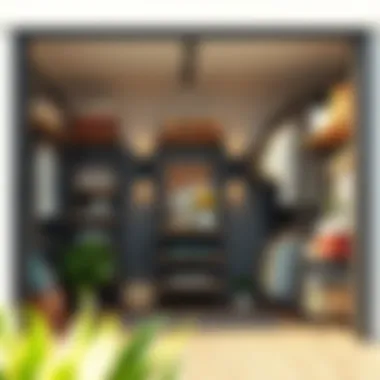
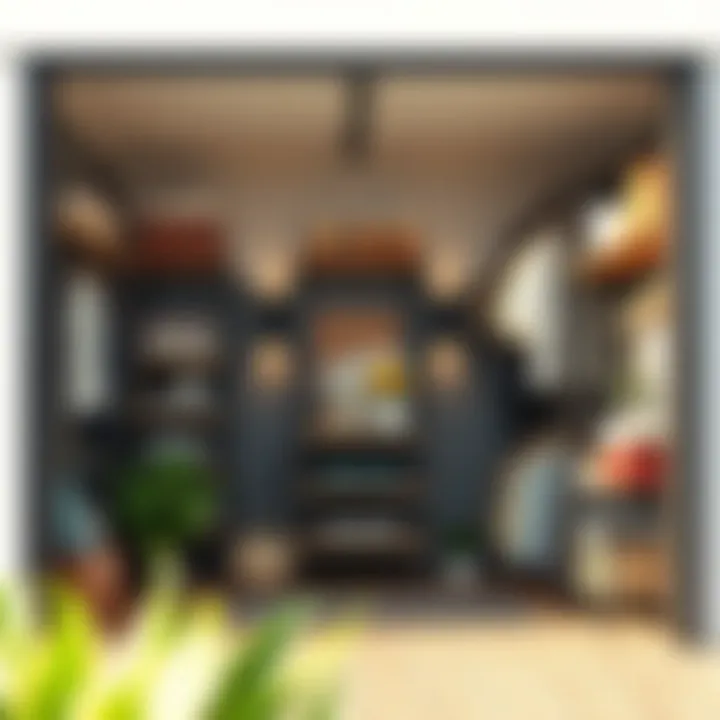
Dimensions and Space Utilization
Dimensions play a significant role in how a vertical shed maximizes space. With limited outdoor areas, every inch counts. When selecting your shed's measurements, consider not only the height and width but also the depth. For instance, a shed that is taller and narrower can offer vertical storage solutions, allowing you to take advantage of often overlooked upward space. This type of configuration promotes efficient organization of tools and materials without encroaching excessively on your yard.
Creating a tailored storage system within the shed is also vital. This can be achieved with shelves that extend to the ceiling. Not only does this utilize vertical space, but it also leaves the floor clear for larger items or workbench setups. Remember, to keep accessibility in mind. No one wants to climb a mountain of boxes to retrieve a rake when they need it. Therefore, design dimensions that allow for an organized and usable interior are key.
Roofing Options
Choosing the right roofing style is essential in both protecting your shed and enhancing its functionality. Here, we look into three popular roofing options—Gable, Flat, and Shed Roofing—each with its unique advantages and considerations.
Gable Roofing
Gable roofing is characterized by two sloped sides that form a peak at the top. This design is beneficial for allowing rain and snow to easily slide off, reducing potential build-up that could damage your shed over time. Moreover, the triangular shape can provide extra attic space, which is great for storing seasonal items. During construction, the gable roof’s angle can easily allow for additional features like ventilation, contributing to the interior climate of your shed.
However, it’s important to consider that gable roofs can be more complex to build. If you're not handy, you might find this style a bit daunting. So keep that in mind when planning.
Flat Roofing
Flat roofing, as the name suggests, is a horizontal design that offers a modern aesthetic. The allure of a flat roof lies in its simplicity and ease of construction. It’s a popular choice for those who favor a clean look and are looking to save budget during setup. Additionally, it can be a perfect platform for placing plants, decorative items, or even outdoor storage, offering a dual-purpose aspect.
Yet, flat roofs can present some challenges. Without proper drainage, water can accumulate and lead to leaks or structural issues over time. You'll want to ensure proper sealing and consider regular inspections to maintain this high-functionality option effectively.
Shed Roofing
Shed roofing is a single-sloped design, leaning in one direction. Traditionally seen in tool sheds, this style is both practical and simplistic. Like flat roofing, shed roofing is generally straightforward to construct and offers good rain runoff, provided that it's installed with appropriate slope. This option is highly functional for small gardens or tight spaces where height restrictions are a concern.
The downside? Shed roofs can lack the aesthetic appeal of a gable design and might not be the best fit in neighborhoods where aesthetics matter. Still, it remains a favored choice for quick, easy functionality without much fuss.
Flooring Alternatives
Having the right foundation is crucial for maintaining the integrity of your vertical shed. Different flooring types can affect durability and usability significantly. Below, we’ll explore three common options: Wooden Flooring, Concrete Slabs, and Portable Floor Systems.
Wooden Flooring
Wooden flooring provides a natural warmth and charm to a vertical shed. Many consider it a beneficial choice due to its aesthetic versatility. You can stain or paint the wood to match the exterior of your shed, making it visually appealing. Furthermore, wood is somewhat forgiving when it comes to temperature shifts, providing a cozy environment for any items stored inside.
However, wooden floors do require regular maintenance to prevent rot or pest infestation. If not cared for properly, moisture can warp the wood over time. Thus, ensuring proper treatment and sealing can be key in selecting wooden flooring for longevity.
Concrete Slabs
Concrete slabs offer a base that is durable and low-maintenance. They provide excellent protection from moisture and pests and make for a sturdy foundation capable of holding heavy equipment without fear of warping. Moreover, concrete floors are easy to clean, which is an added benefit when storing dirtier items like garden tools.
Nevertheless, concrete can be quite cold compared to wood and may not have the same aesthetic options unless additional treatments are applied. Also, it's worth considering that installing a concrete slab requires more work and planning upfront.
Portable Floor Systems
One of the more innovative options out there is the use of portable floor systems. These can be designed to be moved or adjusted based on your storage needs. The flexibility of these systems makes them an attractive choice for those who might change their usage over time. For example, if seasonal items are stored during specific times of the year, this can make things much easier.
On the flip side, portable flooring might not offer the same durability as wooden or concrete options, especially in heavy weather or under considerable weight. Users should evaluate their storage needs carefully before opting for this choice.
Ultimately, a thoughtful approach to the design of your small vertical shed ensures it serves your unique needs without taking up more space than necessary.
Material Choices for Vertical Sheds
When diving into the world of small vertical sheds, material choice becomes a cornerstone of both functionality and aesthetics. The material you opt for can significantly affect not only the durability and maintenance needs of the shed but also its visual appeal in your outdoor space. Choosing the right materials is like picking the right canvas for a masterpiece; each option brings its own blend of character, benefits, and considerations.
Traditional Wooden Sheds
Wooden sheds are often seen as the classic choice for gardeners and outdoor enthusiasts. They provide a natural, rustic charm that can seamlessly blend into various backyard settings. The warmth of wood can enhance the overall ambiance, creating a more inviting atmosphere.
Here are several key aspects to consider:
- Aesthetics: Wooden sheds are highly customizable. You can paint, stain, or leave them in their natural state to suit your style. They can easily fit into a cottage garden or a modern landscape, depending on your design.
- Durability: While wood can be susceptible to rot and pests, well-maintained wooden structures can last for decades. Treatments and regular upkeep are essential to prolong its lifespan.
- Cost: Generally, wooden sheds are more affordable than their metal counterparts but the costs can escalate depending on the type of wood chosen—select hardwood can really drive up expenses.
Metal Sheds: Durability vs. Aesthetics
Metal sheds, primarily constructed from galvanized steel or aluminum, have gained popularity due to their high durability and strength. They are often preferred for both garden storage and tools because of their resistance to elements like water and pests.
However, when considering metal, remember:
- Durability: Metal sheds are resistant to rust, prove fire-resistant, and are often quite sturdy. They can withstand harsh weather, which is advantageous for those in extreme climates.
- Aesthetics: While some metal sheds can look stark or industrial, many manufacturers now offer designs that can fit into residential landscapes. Options such as decorative siding or paint finishes can elevate their appearance.
- Maintenance: Though metal doesn’t require as much upkeep as wood, it may need periodic inspections for scratches and rust spots to maintain its sleek look over time.
Vinyl Sheds: Practicality and Maintenance
Vinyl sheds provide an attractive alternative, standing out for their practicality and low maintenance demands. Made from polyvinyl chloride (PVC), these sheds are engineered for durability without the heft of metal or the maintenance of wood.
Points to ponder include:
- Maintenance: Vinyl sheds require minimal upkeep. Unlike wood, they don’t need painting or staining and can often be cleaned with simple soap and water.
- Durability: Resistant to rot, insects, and fading, vinyl offers a long lifespan, making it a good investment for homeowners who want to avoid the hassle of repairs.
- Cost Considerations: While the initial investment may be higher compared to wood, the longevity and savings from lower maintenance can balance the scales in the long run.
Choosing the right material is crucial, as each brings its unique set of attributes that can significantly impact your shed's longevity, aesthetics, and functionality.
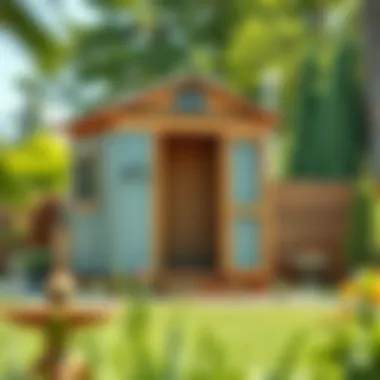
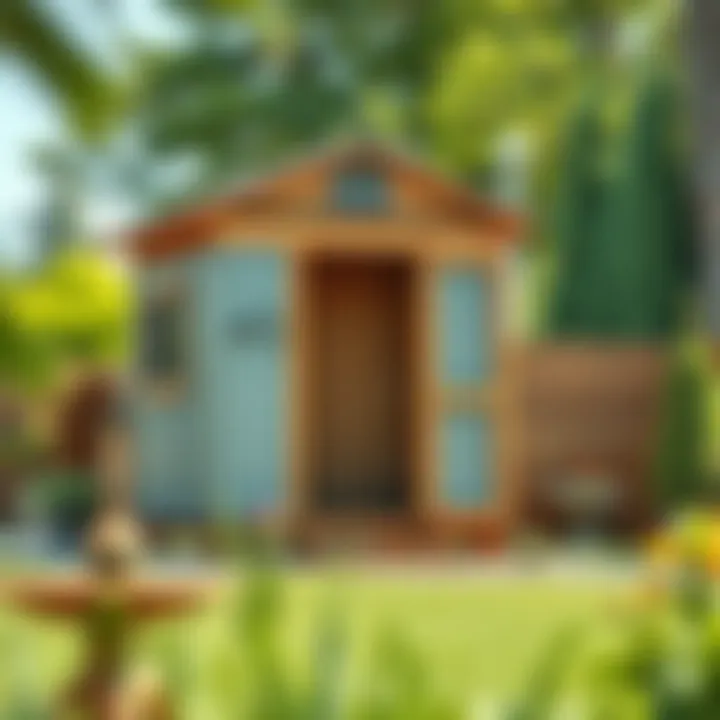
Functional Features to Consider
When it comes to small vertical sheds, functionality is paramount. Homeowners and DIY enthusiasts often seek sheds not just for storage, but for additional features that enhance usability and comfort. By choosing the right functional elements, one can transform a simple shed into a highly efficient workspace or storage solution. Therefore, we delve into key features like storage solutions and ventilation and lighting, helping you make informed decisions that fit your specific needs.
Storage Solutions
Shelving
Shelving is a fundamental aspect of effective storage in any shed. Utilizing vertical space, shelves allow for organized storage and easy access to tools, gardening supplies, and seasonal items. One key characteristic of shelving is its adaptability; adjustable shelves can accommodate items of various sizes, making them a beneficial choice for maximizing limited space.
One unique feature of shelving is the material choice. From wood to metal, each type brings its own advantages. Wooden shelves, for example, can be aesthetically pleasing and easy to install. However, they may require more maintenance compared to metal shelves, which offer superior durability but might lack warmth in appearance.
The benefits are clear: shelves enable verticality in organization, helping you to really take advantage of every inch of space in your shed.
Hanging Systems
Hanging systems are another clever storage solution that draws attention. They enable the use of wall space to store tools, bikes, and other equipment, keeping the floor clutter-free. A key characteristic of these systems is the various configurations available, from hooks to pegboards, allowing for customization according to what you need to store.
Many users find hanging systems to be beneficial, as they enable quick access to frequently-used tools while also promoting better air circulation. One unique aspect of hanging systems is how space-efficient they are, especially for smaller sheds where floor space is precious. However, a downside could be that it may become difficult to locate smaller items when stored on hooks without proper organization.
Cabinetry
Cabinetry adds a touch of organization and elegance to vertical sheds. Cabinets can conceal clutter, bringing a clean aesthetic to your shed while providing ample storage. A key characteristic of cabinetry is its potential for customization; you can have cabinets built to your specific dimensions or opt for pre-fabricated units that fit your needs.
The uniqueness of cabinetry lies in its capacity for secure storage; items stored inside cabinets are fewer likely to gather dust or face adverse weather conditions. However, cabinets can be on the pricier side, and in very small sheds, they may take up too much floor area if not designed efficiently. They definitely help in achieving a neat and appealing shed environment.
Ventilation and Lighting
Good ventilation and lighting are crucial in a small vertical shed, affecting everything from air quality to the utility of the space. A well-lit and ventilated shed is not just more pleasant to work in but also helps in preserving your stored items.
Windows
Windows serve as natural light sources and play an essential role in providing ventilation. One significant aspect of windows is their ability to create a warm environment, inviting natural light that can make the shed feel less cramped. A key characteristic of windows is their ability to be designed openable for airflow, which reduces humidity build-up in the shed.
Another unique trait is the variety of styles available. From sliding to operable, each type has its own advantages and disadvantages in terms of installation and usability. However, security may become a concern if significant items are stored inside, as windows can be a point of entry for unwanted critters or even thieves.
Skylights
Skylights are an excellent addition to vertical sheds, often overlooked. They provide an unobstructed influx of natural light from above. The beauty of skylights is their placement; you can put them where standard windows might not fit, thus maximizing brightness within compact dimensions.
However, a potential downside is heat retention. In warmer climates, skylights can cause the interior to heat up significantly unless proper reflective materials are used. Nevertheless, they create a luminous atmosphere that can uplift the mood while working or organizing.
Ventilation Fans
Not to be missed are ventilation fans, which serve to promote airflow, especially when opening windows isn't a feasible option. They are particularly relevant for sheds that house power tools or other equipment that may produce fumes or moisture. The key characteristic of these fans is their ability to exhaust stale air while drawing in cooler air from outside, creating a refreshing atmosphere.
A unique feature of modern ventilation fans is the use of solar power, making them not only effective but also energy-efficient. However, there could be concerns over noise depending on the fan type, making the sound level a consideration if you plan to spend time inside your shed. Overall, ventilation fans are extremely valuable in maintaining a healthy environment within your versatile space.
Shed Aesthetics and Customization
When it comes to small vertical sheds, aesthetics and customization aren't just the cherry on top; they can be the whole recipe. Homeowners often find themselves torn between functionality and looks, but with vertical sheds, you can indeed have both. An appealing exterior can transform a utilitarian structure into a significant part of your outdoor decor. Moreover, customization allows you to align the shed’s design with your personal style and the existing landscape, which is essential for cohesion in your yard. Here’s how you can bring your shed to life through aesthetics and customization.
Exterior Finishes
Paint Options
Choosing the right paint for your shed can seem trivial, but it plays a pivotal role in how your shed blends with the surrounding environment. Many homeowners opt for vibrant colors that make a statement, while others prefer muted tones that provide a more subdued feel. One key characteristic of paint options is their weather resistance.
Paints formulated for outdoor use protect wood surfaces from moisture and UV rays, extending the longevity of the structure. An additional advantage of painting is its versatility; you can easily refresh your shed's look with a different color as trends and tastes evolve. However, it’s also worth considering that darker colors may absorb more heat, possibly affecting the internal temperature during those hot summer days.
Staining Techniques
Staining offers a unique approach to shed aesthetics, with its emphasis on showcasing the wood grain. Unlike paint, which serves as a barrier, stains penetrate the wood, allowing the natural beauty of the material to shine through. The main attraction here is its natural finish; if you wish to maintain that rustic appeal while providing protection, staining could be your best bet.
Moreover, stains tend to be lower maintenance compared to paint because they don’t chip or peel, allowing for a more seamless experience over time. However, one downside is that the range of color options is somewhat limited when compared to paint, which might not fully meet the desire for vibrant colors.
Cladding Materials
Cladding can bring a unique texture and dimension to your shed, moving beyond the standard wooden or metal finishes. From stone and brick to vinyl and composite materials, cladding can dramatically change the shed's appearance and make it look more like an extension of your house rather than just a storage unit. Choosing cladding offers several benefits; not only does it improve aesthetics, but it can also provide superior insulation and protection from the elements.
One prominent drawback, however, is cost. Quality cladding materials can be more expensive than traditional shed materials, potentially stretching your budget. Still, considering the longevity and return on investment, cladding can be a worthwhile aesthetic enhancement.
Landscaping Around the Shed
Landscaping is the finishing touch that can elevate your vertical shed from merely functional to downright charming. Thoughtfully planned greenery around the shed can soften the hard edges of the structure and help it integrate into the surrounding environment. Materials like pathways or decorative gravel can frame the shed, enhancing its visual appeal.
"Investing in aesthetics and customization might just be the key to creating a shed that is not only functional but also becomes a focal point in your outdoor space."
Incorporating vibrant plants, seasonal flowers, or ornamental grasses can create a lived-in look while also providing additional utility, such as shade or privacy. When you consider the shed's placement in relation to your home and other structures, you're on the path to creating a cohesive outdoor experience.
DIY vs. Professional Installation
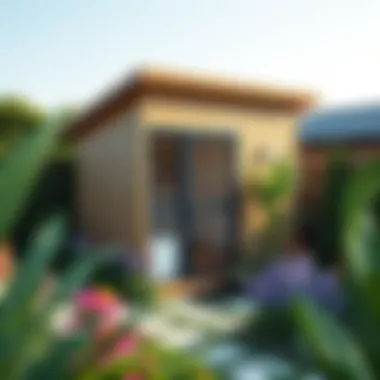
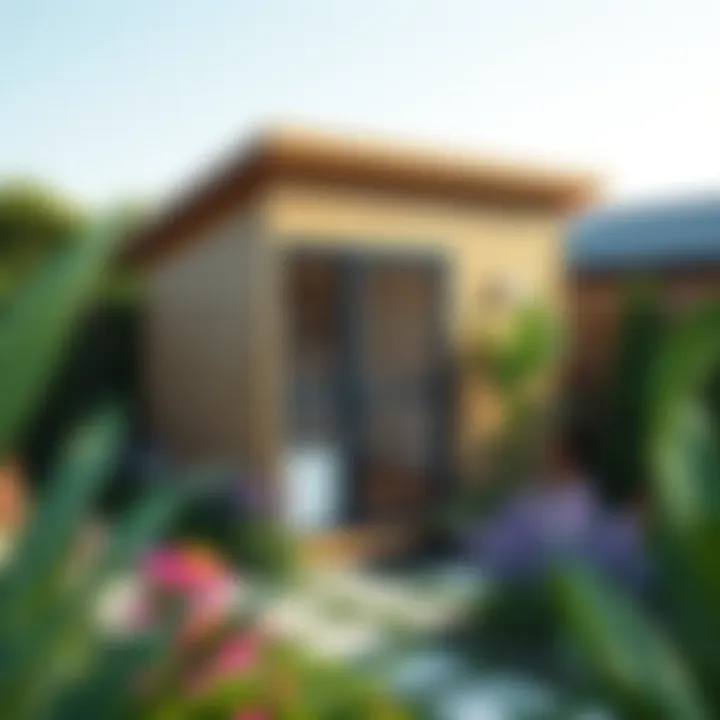
When it comes to erecting a small vertical shed, one of the pivotal decisions homeowners face is whether to tackle the project themselves or hire professionals. This choice can significantly influence not just the timeline and cost, but also the end result in terms of quality and functionality. In this section, we will discuss the pros and cons of both options to help you make the best decision for your shed project.
Assessing Skill Levels and Resources
Before diving into any installation project, it’s essential to take a good, hard look in the mirror — or, more to the point, assess your own skillset and the resources at your disposal. Not everyone is a carpenter or builder, and that's perfectly okay.
Here are some considerations you might find helpful:
- Experience: Have you ever taken on a home improvement task? If the answer's a resounding "no," then maybe playing it safer with a professional isn’t such a bad idea.
- Tools and Equipment: Do you already own the necessary tools like saws, drills, and levels? If not, acquiring these can add to the project's costs. Consider borrowing from friends or investing in cheaper options to save money.
- Time Commitment: Building a shed takes time, and if your schedule is packed tighter than a sardine can, hiring an expert may save you headaches down the road.
These factors can steer your decision as smoothly as a boat sailing down the river.
Cost Considerations
Money matters, and it looms large over the decision-making process when it comes to shed installation. DIY can seem appealing with the prospect of saving pennies, but the reality might be a bit trickier.
- DIY Costs: On the surface, constructing your own shed often looks less pricey. You’ll pay for materials — lumber, nails, roofing — but labor will be your time. Keep in mind that mistakes can spiral costs. If something doesn’t go right, the repairs could hit you hard in the wallet.
- Professional Costs: Hiring a contractor might initially feel like a hefty investment. Yet, a trained eye and steady hands can likely save you money in the long run. They often have established supply chains which can help in procuring materials at reduced prices. If any issues arise post-construction, a pro might even offer guarantees, saving future repair costs.
"Amateurs build sheds; professionals build relationships." This saying encapsulates not just the act of building but also the more nuanced impacts of choosing the right installation method.
Whether you decide to roll up your sleeves or call in the experts, understanding these key elements will help you navigate your shed-building journey with confidence.
Regulations and Permitting
When it comes to small vertical sheds, understanding regulations and permitting is not merely a box-ticking exercise; it's a crucial aspect that can significantly impact construction and usability. Every region has its own rules, and navigating these can save a homeowner from future headaches. Ignoring these can lead to unwanted fines or having to dismantle a shed that isn’t legal.
Understanding Local Building Codes
Local building codes serve as the foundation for what is permissible in terms of construction. These regulations ensure safety, accessibility, and compliance with community standards. While it may seem tedious, getting familiar with these codes is essential.
- Variability: Codes vary widely by location. For instance, a simple shed in Denver may require different considerations compared to one in Miami due to climate, environmental factors, and city planning.
- Zoning Laws: Typically, setbacks and height limits fall under zoning laws. A shed might need to be a specific distance from property lines, and its height could be restricted – which can affect your design choices significantly.
- Safety Regulations: These codes often mandate that structures support certain wind or snow loads, depending on the area. That’s something to keep in mind when deciding on materials or roofing styles.
So, before you rush into building, it’s wise to pick up the local municipal codes, which may be available online at a site like *.gov.
Permitting Processes
The permitting process, while sometimes cumbersome, is a crucial step in ensuring compliance with local regulations. It typically involves a multi-step approach that homeowners and builders must follow:
- Application Submission: Generally, this starts with submitting an application to local building authorities. This document allows the officials to check whether your planned shed aligns with local codes and regulations.
- Documentation: You'll often need to provide detailed plans, including dimensions, materials to be used, and sometimes even proposed landscaping plans. This is where a comprehensive design can work in your favor, as more elaborate submissions can clarify intentions and reduce confusion in reviews.
- Review Period: After submission, the authorities will conduct a review. This can take anywhere from days to several weeks, depending on their workload. During this time, it’s important to keep channels open for any questions they may have.
- Receiving a Permit: If everything checks out, you'll receive a permit. This acts as your green light, giving you the go-ahead to start building.
In some regions, failure to obtain the proper permits can lead to serious ramifications, including fines or being forced to remove the structure entirely. Therefore, understanding and managing the permitting process effectively is not just wise but downright essential.
Remember, regulations exist not solely to be restrictive but to ensure safety and value within communities. Compliance can protect your investment long-term.
Maintenance and Longevity
When it comes to maintaining a small vertical shed, longevity should be a primary focal point for homeowners and DIYers alike. Proper maintenance not only enhances the lifespan of the shed but also ensures that it continues to serve its purpose efficiently. Neglecting routine care might lead to larger headaches down the road—consider it a stitch in time saves nine kind of affair. You’ll want your space to remain functional and aesthetically pleasing, so let’s break down the essential aspects of keeping your shed in top shape.
Routine Maintenance Practices
Regular upkeep is the bedrock of maintaining your vertical shed. Here are some practical tips that can help keep your shed looking sharp and functional:
- Inspect for Damage: Give your shed a once-over, at least twice a year. Look for any signs of wear and tear, particularly after harsh weather.
- Clean the Exterior: Dirt and grime can build up over time. A simple wash with soap and water can go a long way. Consider a mild pressure wash if things are really grimy.
- Check Seals and Roof: Ensure the roof is properly sealed to prevent water ingress. Inspect the seals around doors and windows too, as these areas are often susceptible to leaks.
- Organize the Interior: Keep clutter at bay. An organized shed can help you notice potential issues faster and allows for maximum storage efficiency.
- Treat Wood Surfaces: If your shed is wooden, treat it with appropriate finishes to ward off rotting and insect damage. A coat of stain or sealant doesn’t just look good; it protects.
A well-maintained shed not only serves its purpose but can also add to overall property value.
Identifying Common Issues
Even a well-built vertical shed isn’t immune to problems. Catching these issues early can save you plenty of time, money, and frustration in the long haul. Here are some common concerns to watch out for:
- Rot and Decay: Wood is vulnerable to moisture. If you smell a musty odor or see dark patches, inspect for rot—this usually means your shed is undergoing a slow decay.
- Rust on Metal Components: If your shed features metal parts, keep an eye out for rust. Look at hinges and nails, as they can decay quicker than the rest of your structure.
- Pest Infestations: Uninvited guests like rodents or insects can wreak havoc inside your shed. Make your space less inviting by sealing cracks and holes.
- Structural Integrity: Over time, the foundation may settle, leading to uneven floors or walls. Regularly check that everything remains square and sturdy.
"An ounce of prevention is worth a pound of cure." Knowing what to look for and how to manage these issues will extend the life of your shed significantly.
By adopting a proactive approach to maintenance, you ensure that your vertical shed remains a valuable asset – one that adds utility to your outdoor space without compromising its appearance or function.
The Future of Vertical Sheds
In the realm of outdoor structures, small vertical sheds are poised to play an increasingly significant role, as they combine functionality with efficiency. With the world pivoting toward sustainability and smart technology, these compact havens are adapting to meet the demands of modern homeowners. The importance of looking forward at vertical sheds lies in recognizing their potential as multifaceted spaces that can enhance lifestyle while embracing eco-friendly practices. Keeping an eye on emerging trends allows designers, retailers, and DIY enthusiasts to stay one step ahead, tailoring their offerings to what will resonate in the not-so-distant future.
Trends in Sustainability
As environmental concerns become more pressing, sustainability emerges as a guiding principle in the creation of vertical sheds. The materials and designs of tomorrow's sheds prioritize eco-friendliness, reducing their carbon footprint while maintaining functionality.
- Locally Sourced Materials: Opting for wood or other materials that are sourced nearby not only minimizes transportation emissions but also supports local economies. Homeowners can feel good about making choices that benefit their community and environment.
- Recycled and Upcycled Components: Using recycled metals, plastics, or previously used wood can add a unique touch to a shed, while significantly reducing waste. This practice not only showcases creativity but champions sustainability, aligning with many consumers' values.
- Energy-Efficient Features: Incorporating solar panels and energy-efficient insulation can make vertical sheds self-sufficient. Homeowners may redefine their use of sheds from mere storage spaces to eco-friendly zones that contribute positively to their energy consumption.
Through these sustainable practices, vertical sheds become proactive participants in the fight against climate change, reflecting broader societal shifts towards ecological responsibility.
Smart Shed Technologies
The intersection of technology and construction is revolutionizing how we view vertical sheds. Smart technologies offer practical benefits that extend beyond convenience.
- Smart Sensors and Automation: Homeowners can integrate smart sensors to monitor temperature, humidity, and even security. Automated systems can ensure that tools and equipment remain in optimal condition regardless of outdoor conditions.
- Remote Control and Monitoring: With a smartphone app, users can control lighting, heating, and ventilation remotely, allowing flexibility and peace of mind. A shed that can be accessed from anywhere aligns with our ever-connected lives.
- IoT Devices: The Internet of Things enables vertical sheds to communicate with home systems seamlessly. A shed equipped with IoT devices can optimize its environment for plant nurseries or climate-sensitive tools, providing a controlled atmosphere.
As smart technologies continue to develop, the adaptability of vertical sheds will be unmatched. They evolve from simple storage to smart solutions that can adjust to various needs, making them more relevant than ever.
"The future is not something we enter. The future is something we create." – Leonard I. Sweet















